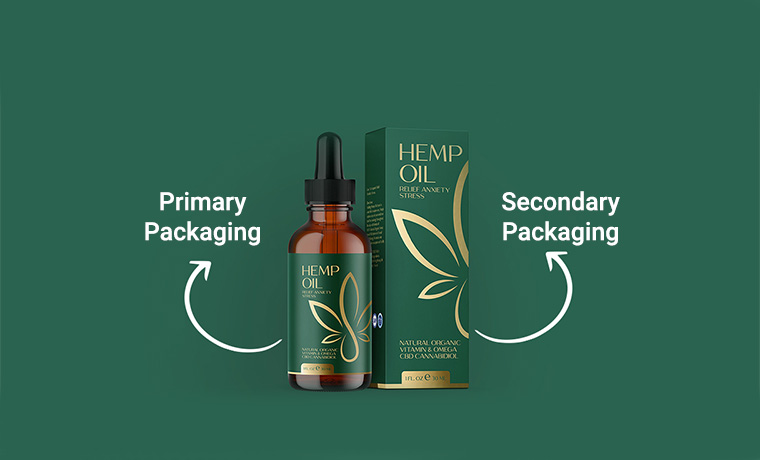Understanding Of Primary and Secondary Packaging - The Ultimate Guide

Packaging plays an important role in packing products offering them protection and serves as a powerful tool in marketing a business. Most commonly there are two types of packaging found. They are primary and secondary packaging. Both of these packaging types are essential in getting the product in the hands of customers and have distinct features and usage. Stay with this guide. We will explore these both types from different aspects and see how they are a good fit to meet a business needs.
What Is Primary Packaging
The definition of a primary packaging is the direct contact with the product specifically designed for protection, preservation, and user convenience. It is a material with the first layer of packaging to protect products from damage and external factors such as contamination, moisture, and light. Plus, it helps to maintain the product's quality, originality and efficacy. This product packaging includes important information like product details, instructions, and safety warnings and offers functionality for the consumer, such as ease of use.
Primary Packaging Examples

Order This Kind Of Boxes In Best Quality From Us
The product manufacturing companies in any industry that produce products in a physical form use primary packaging for their products to make their products look visually appealing while offering convenience in usability. Some of its examples are plastic bags to hold cereal, the aluminum that contain liquid, soap wrappers for nutrition bars, tubes for toothpaste, jars and bottles used in the cosmetic industry. For packing medicines like pills, capsules and other medicinal items, pharmaceutical primary packaging is ideal. Overall, it aims to highlight the product appearance and protect it from various elements.
What Is Secondary Packaging
Secondary packaging is the layer of packaging that contains one or more primary packages. It is not in direct contact with the product but serves to organize, protect, and facilitate the handling of primary packages. This packaging is specifically designed to store and protect primary packages during transportation, offers efficient handling, and enhances branding. Usually, it contains a label providing information about the products while promoting your brand.
Secondary Packaging Examples

Order This Kind Of Boxes In Best Quality From Us
The most common examples of secondary packaging are folding carton boxes for storing toothpaste tubes, a cereal box for storing cereal bags, a cardboard box to hold a blister of medicines, mailer boxes for holding cream bottles, and display boxes to showcase a set of products like nutrition bars.
In the pharmaceutical industry, from manufacturing to distribution of pharmaceutical products, pharmaceutical secondary packaging is perfect to surround primary packages of pharmaceutical products. They protect primary packaging from damage during transit and provide additional space for product details and branding.
Primary Vs Secondary Packaging - Major Differences
Both primary and secondary packaging are essential in the packaging industry and serve many industries in different ways. The primary packaging comes in direct contact with the product on the other hand, secondary packaging does not. In simple words, primary packaging is a packaging material that contains the main product and shields it from various external damaging elements while offering functionality and aesthetics.
The secondary packaging keeps the individual unit of primary packages together for easy storage, shipping and transportation. Providing essential product information and aesthetic appeal secondary packaging also plays a significant role in establishing a brand identity and leave a lasting impact on customers.
Material Selection For Primary and Secondary Packaging Offering The Utmost Protection
Primary packaging is affected by reaction from the products. Therefore it is essential to choose a material that is highly compatible with the product and withstand the chemical properties of the products. A material called Acrylic popular for its versatility and durability is quite often used in chemical resistance. Glass is another common material offering excellent chemical resistance and is also a suitable choice for products that require extreme protection from potential reactions and harmful environmental elements.
Secondary packaging is the outer layer of packaging providing additional protection to primary packages of the products. For this, the packaging boxes made from durable paperboard offering strength and flexibility are perfect in secondary packaging. Choose a material that offers functionality and eco-friendliness while serving and protecting primary packages.
Primary Secondary and Tertiary Packaging

Order This Kind Of Boxes In Best Quality From Us
There are three types in the packaging industry. They are primary, secondary and tertiary. The primary packaging is directly connected with the product offering it appealing appearance and protection. For packing medicines like pills, capsules and other medicinal items,, pharmaceutical primary packaging is ideal.
While using the secondary packaging machine, multiple units of products are grouped in a secondary packaging to protect them during transit.
As far as the tertiary packaging is concerned, it is a larger and third type of packaging that facilitates the handling and transportation of bundled secondary packages inside the warehouses.
For an understanding, let’s take an example of wine. The wine is poured in the bottle. This wine bottle is the primary packaging. A brown cardboard box as a secondary packaging is used to pack and protect the wine bottle. The tertiary packaging with a cardboard box, pallet and shrink wrap comes in to group multiple wine boxes together.





